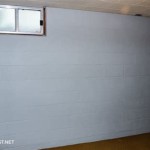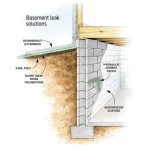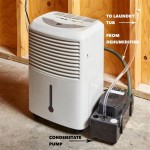How To Seal A Basement Leak
If you're dealing with a basement leak, you know how frustrating and damaging it can be. Water can seep in through cracks in the foundation, walls, or floor, causing mold, mildew, and structural damage. The good news is that sealing a basement leak is often a relatively simple and inexpensive fix. With the right tools and materials, you can do it yourself in a few hours.
Identifying the Source of the Leak
The first step is to identify the source of the leak. This can be tricky, especially if the leak is small. Look for signs of water damage, such as mold, mildew, or stains on the walls or floor. You can also use a moisture meter to help you locate the leak. Once you've found the source of the leak, you can start to seal it.
Sealing the Leak
There are a few different ways to seal a basement leak, depending on the type of leak. Here are some of the most common methods:
- Patching cracks: If the leak is coming from a crack in the foundation, you can seal it with a hydraulic cement or epoxy patch. These materials are designed to expand and fill cracks, creating a watertight seal.
- Sealing joints: If the leak is coming from a joint between two pieces of concrete, you can seal it with a silicone caulk or sealant. These materials are flexible and will create a watertight seal that can withstand movement.
- Installing a sump pump: If the leak is coming from a low-lying area of the basement, you may need to install a sump pump. A sump pump is a small pump that will automatically remove water from the basement.
Preventing Future Leaks
Once you've sealed the leak, you'll want to take steps to prevent future leaks. Here are a few tips:
- Keep gutters and downspouts clean: Clogged gutters and downspouts can cause water to overflow and seep into the basement.
- Grading the soil around your home: The soil around your home should slope away from the foundation. This will help to prevent water from pooling around the foundation and seeping into the basement.
- Sealing foundation cracks: If you notice any cracks in the foundation, seal them promptly to prevent water from seeping in.
Conclusion
Sealing a basement leak is a relatively simple and inexpensive fix that can save you a lot of money and hassle in the long run. By following these tips, you can identify the source of the leak, seal it, and prevent future leaks.

Basement Leak Repair How To Seal And Prevent Leaks

Waterproofing Basement Walls Dos And Don Ts To Remember Bob Vila

Diy Basement Waterproofing Sealonce System Easy Installation Waterproof Com

How To Waterproof Basement Walls With Flex Seal Products Youtube

The 3 Major Approaches To Basement Waterproofing News And Events For Systems Inc

The Best Methods For Basement Leak Repair Acculevel

How Does Interior Basement Waterproofing Work

How To Seal Basements Keep Water Out Regional Foundation Repair

Waterproofing Basement Walls Dos And Don Ts To Remember Bob Vila

What Causes Leaky Floors In Basements Fixing Leaking Basement








